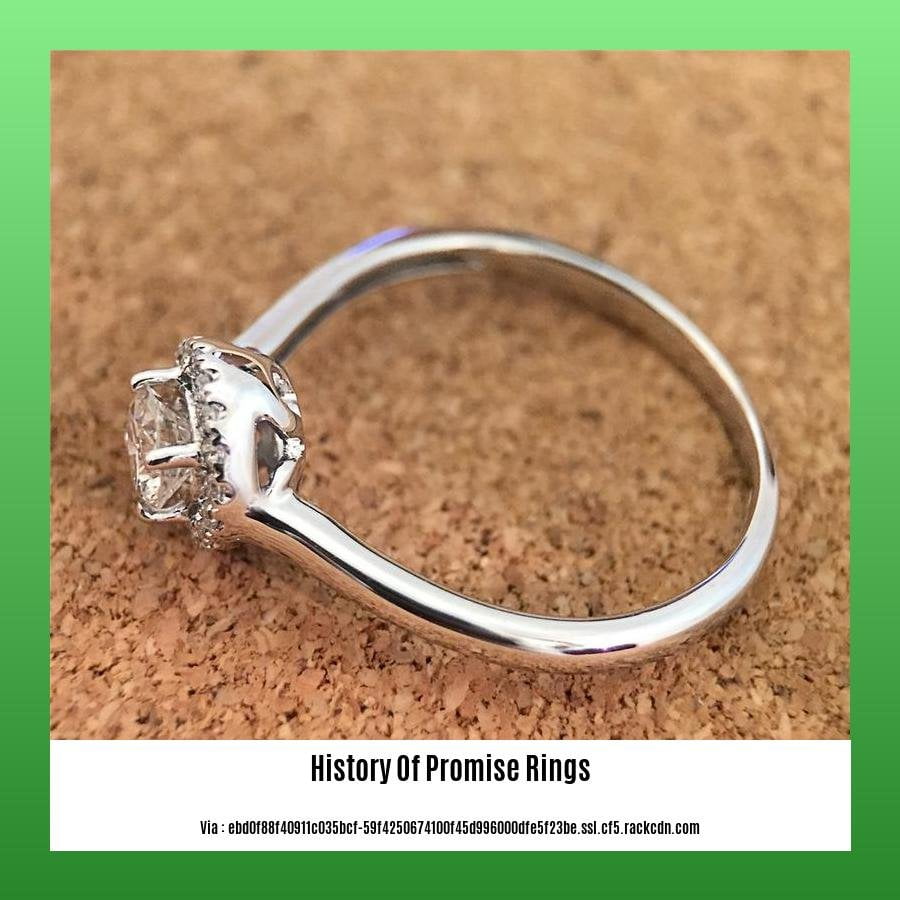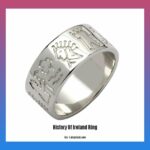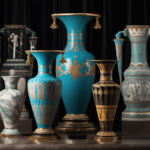Embark on a captivating journey through the annals of history as we unveil the intriguing story of promise rings. From their humble beginnings in ancient civilizations to their enduring significance in modern times, these timeless tokens of affection have played a pivotal role in shaping human relationships. Join us as we delve into the rich cultural tapestry of promise rings, exploring their evolution, symbolism, and the enduring legacy they have left on our collective consciousness. Discover the fascinating tales behind these cherished adornments in our article titled [A Walk Through Time: Unveiling the History of Promise Rings].
Key Takeaways:
Promise rings have existed for centuries, tracing back to ancient civilizations such as Egyptians, Greeks, and Romans.
The origin of promise rings is uncertain but is believed to have emerged during the 16th century.
During the medieval era, promise rings were commonly exchanged as love or friendship tokens, often engraved with love poems.
In ancient Rome, brides wore engagement rings in the 2nd century BC, contributing to the idea of promise rings symbolizing betrothal or engagement.
Promise rings evolved over time, becoming popular during the 16th century when young men gifted them to their girlfriends.
History of Promise Rings
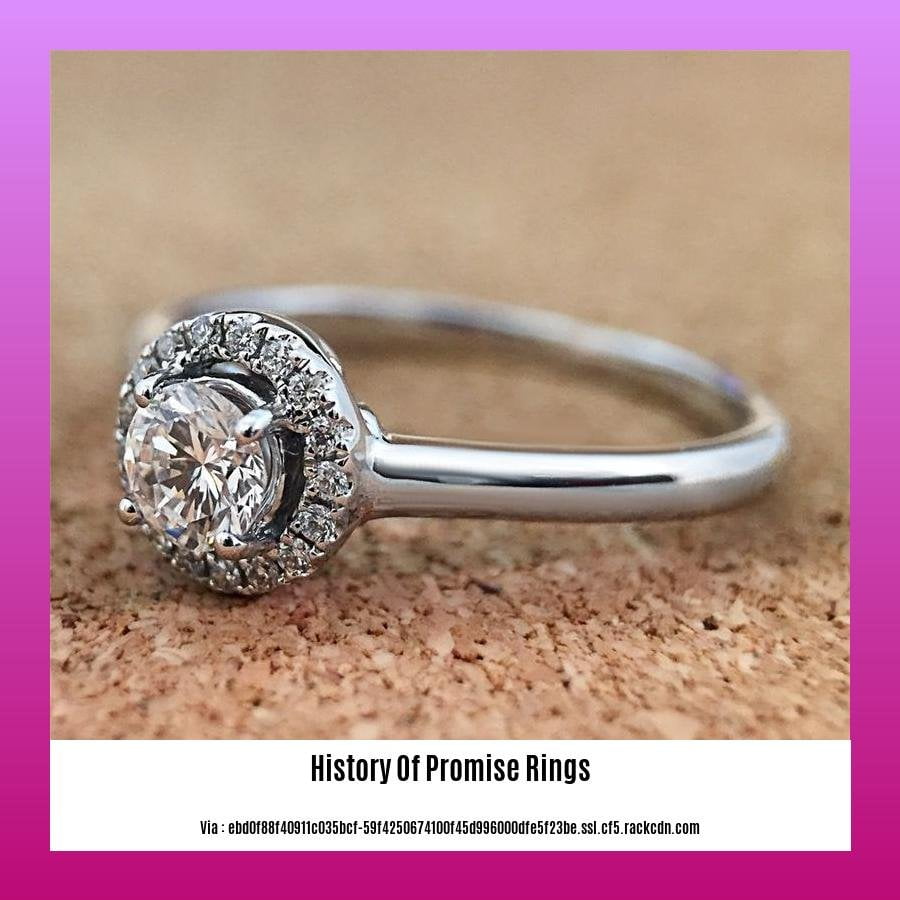
Let’s take a fascinating journey through the annals of history, uncovering the captivating evolution of promise rings. From ancient civilizations to the modern era, these rings have played a significant role in symbolizing love, commitment, and the promise of a shared future.
Ancient Symbolism: A Legacy of Love
The history of promise rings can be traced back to the ancient world. In ancient civilizations like Egypt, Greece, and Rome, rings were exchanged as tokens of affection, friendship, and marital intent. These early rings were often crafted from precious metals like gold or silver and adorned with intricate designs or gemstones.
In ancient Rome, brides wore engagement rings as a symbol of their impending nuptials. These rings were often made of iron or bronze and engraved with the names of the bride and groom.
Medieval Romance: Rings of Love and Fidelity
During the medieval era, promise rings gained popularity as mementos for lovers. These rings were often engraved with brief love poems or sentimental messages. They served as tokens of fidelity and commitment, representing the promise of a lasting relationship.
The tradition of exchanging promise rings became particularly popular among the nobility. These rings were often adorned with precious gemstones and intricate designs, symbolizing the wealth and status of the wearer.
16th Century: A Shift in Meaning
In the 16th century, the meaning of promise rings began to evolve. It became customary for young men to give their girlfriends rings as a token of love or friendship. These rings were not necessarily indicative of an engagement or marriage proposal but were rather a symbol of affection and commitment.
During this time, promise rings were often made of gold or silver and featured simple designs. They might be engraved with the initials of the giver and the recipient or with a love poem or symbol.
Modern Interpretation: A Promise of Many Forms
In the modern era, the history of promise rings has taken a new turn. Promise rings are no longer exclusively associated with romantic love. They are also exchanged as a symbol of friendship, commitment to a cause, or as a reminder of a special bond.
Today, promise rings come in a wide variety of styles and designs. They can be made of precious metals, gemstones, or even wood or leather. The meaning of a promise ring is unique to the individuals who exchange it, making it a deeply personal and meaningful symbol.
If you have been fascinated about the history of prom, you are in luck! Read an interesting article to know more about its history here: history of prom. Similarly, if you have wondered about the history of pharmacopoeia in pharmaceutical inorganic chemistry, the details about its past are discussed in this article, check it out: history of pharmacopoeia in pharmaceutical inorganic chemistry.
Evolution of Promise Rings Over Time: Discussing the changing significance of promise rings throughout history, from ancient symbols of fidelity to modern expressions of commitment.
Imagine an ancient Roman bride adorned with an iron or bronze ring, etched with her name and her betrothed’s, a tangible symbol of their impending union. Fast forward centuries, and a medieval lover bestows upon his sweetheart a ring engraved with a love poem, a tender token of his enduring devotion. In the 16th century, young men offered rings to their beloveds, not as a marriage proposal but as a pledge of affection and commitment.
And in the modern era, promise rings have transcended romantic love, becoming symbols of friendship, personal commitment, or a cause. Promise rings have indeed come a long way, their meanings evolving with the times, yet always embodying the essence of commitment, love, and the hope for a future together.
Key Takeaways:
Promise rings, steeped in history, have symbolized affection, friendship, and marital intent since ancient times.
Ancient Rome introduced engagement rings as symbols of impending nuptials, crafted from iron or bronze and engraved with the couple’s names.
Medieval promise rings, engraved with love poems or sentimental messages, represented the promise of lasting relationships.
In the 16th century, promise rings were given as tokens of love or friendship, not necessarily indicating an engagement, but rather expressing affection and commitment.
Today, promise rings are not limited to romantic relationships, but also symbolize friendship, commitment to a cause, or a reminder of a special bond.
The Promise Ring’s Modern Metamorphosis
In the 19th century, promise rings gained popularity in the United States, often exchanged between couples as a symbol of their commitment to each other before marriage. This tradition continues today, with many couples choosing to exchange promise rings as a way to express their love and commitment to one another. Promise rings are also given as a symbol of friendship, loyalty, or support.
A Timeless Tradition Reinvented
Promise rings have evolved over time, reflecting the changing values and customs of society. However, the core meaning of a promise ring remains the same: a symbol of commitment, love, and hope for the future. Whether exchanged between romantic partners, friends, or family members, promise rings serve as a tangible reminder of the special bond that unites two individuals.
References
[1]
[2]
The Role of Promise Rings in Betrothal and Marriage
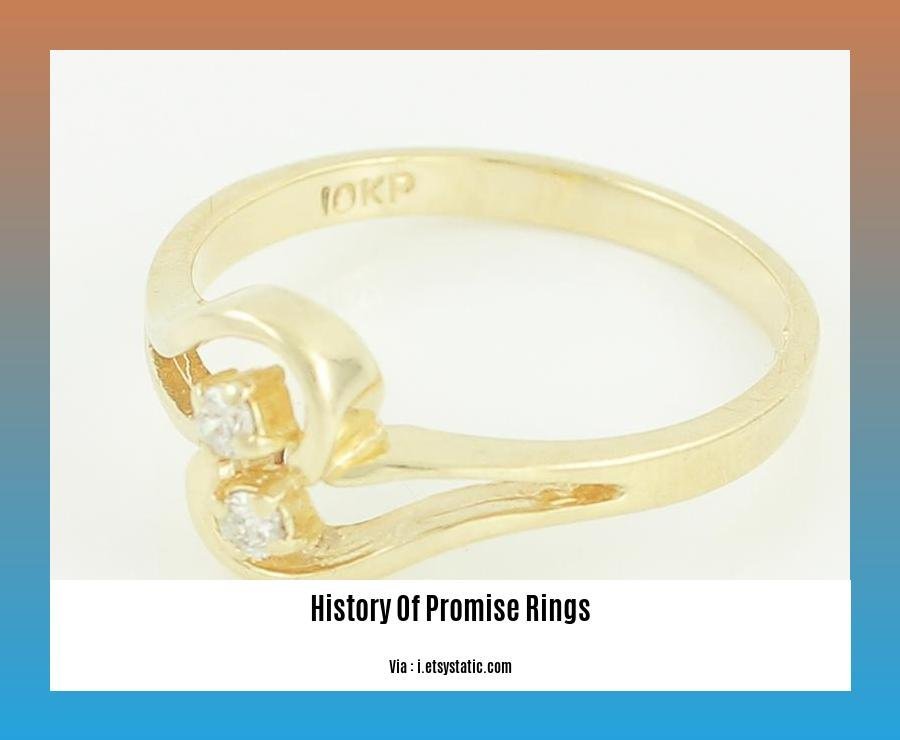
Have you ever wondered about the historical significance of promise rings? These exquisite bands of metal and gemstones hold a rich and multifaceted history, deeply intertwined with the evolution of betrothal and marriage customs across cultures and eras. Let’s embark on a journey through time to explore the fascinating role promise rings have played in shaping our understanding of love, commitment, and fidelity.
Ancient Origins: Tokens of Affection and Intent
In ancient civilizations, the exchange of promise rings dates back centuries, embodying various meanings. In ancient Rome, these rings symbolized a marriage contract, a tangible representation of two souls uniting their lives. Crafted from iron or bronze, these rings often bore the names of the bride and groom, symbolizing their commitment to each other.
Medieval Courtship: Expressions of Love and Devotion
During the medieval era, promise rings took on a new significance. They became cherished mementos between lovers, engraved with brief love poems or heartfelt messages. These rings served as tangible reminders of a lasting relationship, a promise of unwavering devotion amidst the uncertainties of life.
Renaissance Symbolism: Fidelity and Commitment
The Renaissance period witnessed a surge in the popularity of promise rings. Paintings from this era often depicted rings as symbols of love, fidelity, and commitment. These rings were not merely decorative accessories but powerful representations of the deep emotional connections between individuals.
Early Modern Era: Tokens of Friendship and Affection
In the 16th century, the meaning of promise rings evolved once more. Young men began presenting their girlfriends with rings as tokens of love or friendship. These rings did not necessarily signify an engagement or marriage proposal but conveyed a profound sense of affection and commitment.
Modern Expressions: Love, Friendship, and Personal Commitments
In the modern era, promise rings have transcended their traditional romantic connotations. They now symbolize a wide range of commitments, including friendship, loyalty to a cause, or as a personal reminder of a special bond. Promise rings have become a versatile symbol of love, support, and unity, transcending cultural and societal boundaries.
Key Takeaways:
Promise rings have a rich history, dating back to ancient civilizations.
They have symbolized everything from marital intent to friendship and personal commitments.
Promise rings were often exchanged in lieu of engagement rings in the past.
The meaning of promise rings has evolved over time, reflecting changing social and cultural norms.
Today, promise rings are a popular way to express love, commitment, and hope for the future.
Relevant URL Sources:
Modern Interpretations of Promise Rings: Investigating contemporary trends and variations in the use of promise rings, including their significance in non-traditional relationships and the emergence of new ring designs and styles.
In the ever-evolving tapestry of human relationships, the promise ring has taken on newfound significance in the modern era, reflecting the kaleidoscope of connections that define our lives today. Let’s explore this fascinating journey, uncovering contemporary trends and variations that redefine the meaning of promise rings in non-traditional relationships and unveil the emergence of innovative ring designs that capture the spirit of our times.
Key Takeaways:
Promise rings are no longer confined to romantic relationships; they symbolize commitment, friendship, and personal aspirations.
Non-traditional relationships, such as committed partnerships and long-distance relationships, find solace and expression in the exchange of promise rings.
New ring designs break free from conventional norms, incorporating unique materials, intricate engravings, and personalized touches that reflect individual style.
Promise rings empower individuals to express their unique commitments, celebrating diversity and inclusivity in relationships.
The rise of unisex and gender-neutral promise rings reflects the fluidity and acceptance of modern relationships.
Promise rings serve as a tangible reminder of shared values, fostering a sense of unity and connection among individuals.
Non-Traditional Relationships and the Promise Ring
In the modern landscape of relationships, promise rings have evolved beyond their traditional romantic associations. They now play a vital role in non-traditional relationships, offering a tangible symbol of commitment, love, and support.
Long-Distance Relationships: Promise rings bridge the physical gap in long-distance relationships, serving as a symbol of enduring connection and a reminder of shared love.
Committed Partnerships: In partnerships where marriage is not a priority or immediately feasible, promise rings provide a meaningful representation of commitment, fidelity, and mutual support.
Friendship: Promise rings can deepen the bond of friendship, symbolizing loyalty, shared experiences, and unwavering support through life’s journey.
Personal Aspirations: Promise rings can represent an individual’s commitment to personal goals, dreams, or causes, serving as a tangible reminder of one’s aspirations and determination.
New Ring Designs: Embracing Uniqueness
The realm of promise ring designs has witnessed a surge of creativity, breaking away from traditional conventions and embracing individuality. Jewelers and designers are pushing boundaries, crafting rings that reflect the wearer’s personality and the unique nature of their relationships.
Uniqueness and Personalization: Modern promise rings showcase a wide array of styles, from delicate bands with intricate engravings to bold, statement pieces adorned with gemstones.
Unisex and Gender-Neutral Designs: Reflecting the fluidity of modern relationships, unisex and gender-neutral promise rings have gained popularity, allowing individuals to choose rings that align with their personal style and preferences.
Sustainable and Ethical Materials: In keeping with contemporary values, many promise rings are crafted using sustainable materials, recycled metals, and ethically sourced gemstones, echoing a commitment to environmental responsibility.
Symbolic Elements: Designers incorporate symbolic elements into promise rings, such as birthstones, infinity symbols, or personalized engravings, adding a layer of personal meaning to each piece.
Conclusion: A Reflection of Our Times
The transformation of promise rings in the modern era mirrors the changing landscape of relationships and the evolving values of our society. These rings have become a symbol of diverse commitments, empowering individuals to express their unique connections and aspirations. As we embrace inclusivity, individuality, and personal expression, promise rings continue to evolve, capturing the essence of modern relationships in all their vibrant forms.
References:
Promise Rings: A Modern Interpretation
FAQ
Q1: What is the origin of Promise rings?
A1: The exact history of promise rings is unclear, but they are believed to have originated in the 16th century, with customs of exchanging rings as tokens of love or friendship as far back as ancient civilizations like the Egyptians, Greeks, and Romans.
Q2: How did Promise rings evolve over time?
A2: Promise rings evolved during the medieval era, serving as mementos for lovers and often engraved with brief love poems. They gained popularity and became a symbol of betrothal or engagement, as in ancient Rome, where brides wore engagement rings as early as the 2nd century BC.
Q3: What was the purpose of Promise rings in the past?
A3: In the past, promise rings were given by young men to their girlfriends as tokens of love, friendship, or as mementos for lovers, often engraved with brief love poems. They also held significance as symbols of betrothal or engagement, with brides wearing engagement rings in ancient Rome as early as the 2nd century BC.
Q4: What is the significance of Promise rings today?
A4: Today, promise rings symbolize many things, including commitment, love, and the hope for the development of a relationship. They are not the same as engagement rings and do not promise marriage but can be given in various contexts, including romantic relationships, friendships, or as a symbol of personal commitment.
Q5: Can Promise rings be worn by anyone?
A5: Yes, promise rings can be worn by anyone, regardless of age, gender, or relationship status. They are a personal and meaningful way to express love, commitment, or hope for the future.
- China II Review: Delicious Food & Speedy Service - April 17, 2025
- Understand Virginia’s Flag: History & Debate - April 17, 2025
- Explore Long Island’s Map: Unique Regions & Insights - April 17, 2025
